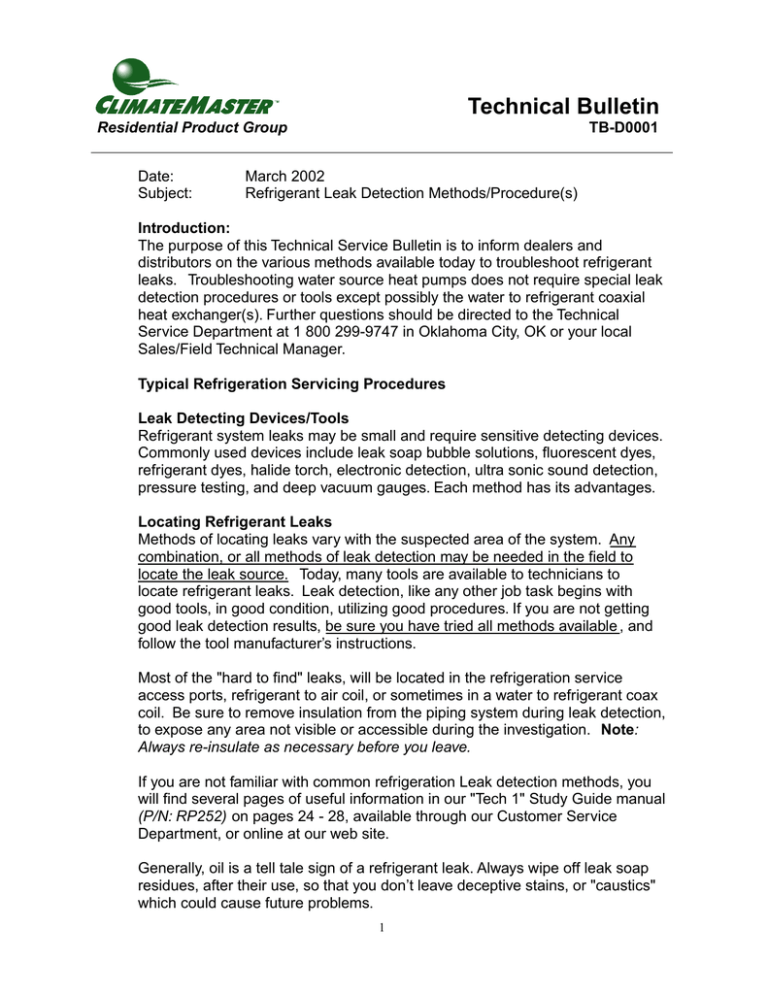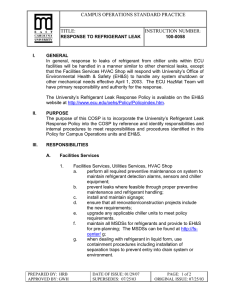Technical Bulletin
advertisement

Technical Bulletin Residential Product Group Date: Subject: TB-D0001 March 2002 Refrigerant Leak Detection Methods/Procedure(s) Introduction: The purpose of this Technical Service Bulletin is to inform dealers and distributors on the various methods available today to troubleshoot refrigerant leaks. Troubleshooting water source heat pumps does not require special leak detection procedures or tools except possibly the water to refrigerant coaxial heat exchanger(s). Further questions should be directed to the Technical Service Department at 1 800 299-9747 in Oklahoma City, OK or your local Sales/Field Technical Manager. Typical Refrigeration Servicing Procedures Leak Detecting Devices/Tools Refrigerant system leaks may be small and require sensitive detecting devices. Commonly used devices include leak soap bubble solutions, fluorescent dyes, refrigerant dyes, halide torch, electronic detection, ultra sonic sound detection, pressure testing, and deep vacuum gauges. Each method has its advantages. Locating Refrigerant Leaks Methods of locating leaks vary with the suspected area of the system. Any combination, or all methods of leak detection may be needed in the field to locate the leak source. Today, many tools are available to technicians to locate refrigerant leaks. Leak detection, like any other job task begins with good tools, in good condition, utilizing good procedures. If you are not getting good leak detection results, be sure you have tried all methods available , and follow the tool manufacturer’s instructions. Most of the "hard to find" leaks, will be located in the refrigeration service access ports, refrigerant to air coil, or sometimes in a water to refrigerant coax coil. Be sure to remove insulation from the piping system during leak detection, to expose any area not visible or accessible during the investigation. Note: Always re-insulate as necessary before you leave. If you are not familiar with common refrigeration Leak detection methods, you will find several pages of useful information in our "Tech 1" Study Guide manual (P/N: RP252) on pages 24 - 28, available through our Customer Service Department, or online at our web site. Generally, oil is a tell tale sign of a refrigerant leak. Always wipe off leak soap residues, after their use, so that you don’t leave deceptive stains, or "caustics" which could cause future problems. 1 Refrigeration service access port caps, missing, left off, without gaskets, or over tightened will often be overlooked. Occasionally, schrader valves may leak after accessing the system. Check them. Refrigerant to air coils, suspected of leaking may be in hard to reach areas like the rear "u-bend" end plate located deep inside the unit cabinet, or on the air entering side of the air coil located in the return air duct work, or even internal of the copper/aluminum finned area of the air coil itself. Be sure to investigate all areas removing return air ductwork, or cabinet panels as necessary to gain clear access. Should you determine the leak is in the air coil, careful consideration should be given to indoor air quality. Independent studies done by ClimateMaster as well as outside vendors have indicated that air coil leaks such as "pin holes" in the copper air coil, maybe due to outside forces generally caused by "corrosives" in the indoor air stream. Thought should be given to the installation and its surroundings to identify possible causes, which might be the source of the problem. Safeguards such as removal or better containment of the "pollutants" and use of devices such as "heat recovery ventilators" may be worth considering. Coated air coils are available by Special Request, but are not a final solution to all problematic jobs. Water to refrigerant coax coils, suspected of leaking through into the water side, may be one of the hardest leak sources to detect. Here are a few field proven methods to confirm this case. Refrigerant gas in the water - test: While the refrigerant system is under pressure, the water or loop fluid in the water side of the refrigerant coaxial heat exchanger may contain refrigerant gas, detectable by the halide or electronic "sniffer" type of leak detectors. This can be easily sampled by isolating the water in the water side connections of the coax and taking a water sample for testing. Using two (2) P/T gauge port adapters (P/N: APGTA) and domestic water supply pressure utilizing a garden hose with some iron pipe/hose fittings and plumbing valves (available locally), you can remove a fluid sample from the P/T Ports located near the brass swivel fittings on the water connections of the unit. Note: See the drawings included on the last page of this bulletin . Be careful to purge all air from the garden hose, so you do not introduce air to a closed loop installation. Coffee Filter Paper - test: Provided you have introduced fluorescent ultraviolet leak dye in the refrigerant system, allow it sufficient time to circulate (typically 48 hours or more). Then isolate the water side of the refrigerant coaxial heat exchanger and remove a sample of water from the "water out" side of the coaxial connection (typically the coax holds 1 gallon or less). Dump the water sample through a "coffee filter" 2 paper. This will normally "sieve" or "strain" the oil(s) from the water solution. If refrigerant oil has leaked out with refrigerant into the water side, the "dye" will usually be detectable on the coffee filter paper with the Ultra violet light. Nitrogen Pressure test: During a dry nitrogen "pressure test", shutting off the water flow path to the water to refrigerant coaxial heat exchanger via "3-way" isolation valves on a closed loop (geothermal loop) flow center, or the field installed "ball valves" on a open loop (well water) piping system will allow the technician to use the "Pressure Gauge (P/N: APG100) and P/T port Adapter (P/N: APTGA)" to monitor the static pressure in the water side of the coaxial heat exchanger at the P/T ports near the unit. Should refrigerant leak into the water side of the system, the dial gauge pressure will "rise" with the increase in nitrogen pressure being applied to the refrigeration system. Sometimes it may be necessary to isolate components, and test them individually to confirm the actual leak source area. However, all methods have one procedure in common: applying pressure to the system with an inert gas, such as dry nitrogen. Refrigerant gas sometimes may be mixed as a tracer with these, to enable halide or electronic "sniffer" units to detect the leak source. Nitrogen gas has a lower specific gravity than most refrigerants, therefore may penetrate the system piping, and disclose the source of the leak quicker. At the start of testing, a positive pressure (greater than atmospheric pressure) of 5 psig to 30 psig (20 psia to 45 psia or 138 kPa to 310 kPa) is necessary throughout the circuit. If no leaks are found, test again at or above the normal condensing pressure for the refrigerant used. Note: Always check for leaks before the unit is evacuated. Moisture could enter the system through a water side refrigerant leak during evacuation or pump-down. Always use the proper recycle/recover equipment when locating and repairing leaks, (this should include digital vacuum test gauge instruments). If a leak is found and repaired, the complete unit must be rechecked. This provides a check for the repair and will reveal any additional leaks. Pressure-Testing for Leaks With proper care, dry nitrogen may be used safely when pressure-testing for leaks. This is the obvious and easiest method of leak detection. The pressure in the nitrogen cylinder is about 2000 psig (14 Mpa). An approved pressurereducing device that has both a pressure regulator and a pressure relief valve must always be used when testing with dry nitrogen. A refrigerating system can explode if pressure is allowed to build up in the system. Many accidents have been caused by using too much testing pressure. Before using nitrogen or carbon dioxide to test a system, look at the system nameplate. In most cases, it will give recommended testing pressures. If these pressures are not known, 3 never test all or part of a hermetic system at a pressure over 170 psig (185 psia or 1280 kPa). Caution: Never use oxygen or acetylene to develop pressure when checking for leaks. Oxygen will cause an explosion in the presence of oil. Acetylene will decompose and ex-plode if it is pressurized over 15 psig to 30 psig (30 psia to 45 psia or 210 kPa to 310 kPa). Sketch Drawing of Water Sample Removal Method * Close 3 way valves to isolate unit from Loop Hot Water Tank *Field supplied garden hose for water supply pressure *Field supplied container for sample fluid solution ClimateMaster P/N: APTGA .25" MPT Pipe Nipple .25" x .50" MPT Red. Coupling .50" MPT Brass Boiler Drain Valve Qty (2 ea.) Service Valve Assembly needed for Fluid Removal Tool 4


